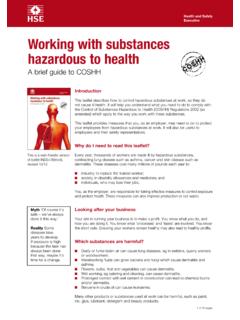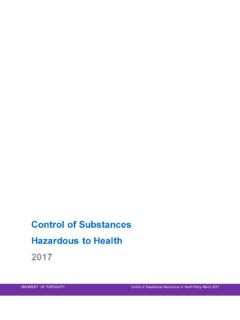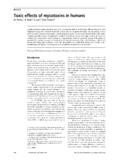Transcription of Methyl Bromide (Bromomethane) - US EPA
1 Methyl Bromide ( bromomethane )74-83-9 Hazard SummaryMethyl Bromide is used as a fumigant and pesticide. Exposure may occur during fumigation activities. Methyl Bromide is highly toxic . Studies in humans indicate that the lung may be severely injured by theacute (short-term) inhalation of Methyl Bromide . Acute and chronic (long-term) inhalation of methylbromide can lead to neurological effects in humans. Neurological effects have also been reported inanimals. Degenerative and proliferative lesions in the nasal cavity developed in rats chronically exposed tomethyl Bromide by inhalation.
2 Chronic inhalation exposure of male animals has resulted in effects on thetestes at high concentrations. EPA has classified Methyl Bromide as a Group D, not classifiable as tohuman Note: The main sources of information for this fact sheet are EPA's Integrated Risk Information System (IRIS) (3), which contains information on inhalation chronic toxicity of Methyl Bromide and the RfC, oral chronic toxicity and the RfD, and the Agency for toxic Substances and Disease Registry's (ATSDR's) Toxicological Profile for bromomethane .
3 (1) Other secondary sources include The Merck Index (7) and EPA's Health Effects Assessment for bromomethane . (5)UsesThe primary use of Methyl Bromide is as a fumigant in soil to control fungi, nematodes, and weeds; in space fumigation of food commodities ( , grains); and in storage facilities (such as mills, warehouses, vaults, ships, and freight cars) to control insects and rodents. (2,7,10)Sources and Potential ExposureIn most places, levels of Methyl Bromide in the air are usually < parts per billion (ppb).
4 Industrial areas have higher levels (ranging up to ppb) because of releases from chemical factories. (1) Workers who fumigate homes and fields may be exposed to high levels of Methyl Bromide if proper safety precautions are not followed. (1)Trace amounts of Methyl Bromide have been detected in drinking water. (2)Some Methyl Bromide is formed naturally by algae or kelp in the ocean. (1)Assessing Personal ExposureThe main breakdown product of Methyl Bromide (the Bromide ion) can be measured in blood samples; this test is useful only if it is done within 1 to 2 days following exposure.
5 (1)Health Hazard InformationAcute Effects:Studies in humans indicate that the lung may be most severely injured by the acute inhalation exposure of Methyl Bromide . Breathing high concentrations of Methyl Bromide may cause pulmonary edema, impairing respiratory function. (1,3)Acute exposure by inhalation of Methyl Bromide frequently leads to neurological effects in exposure by inhalation of Methyl Bromide frequently leads to neurological effects in humans. Symptoms of acute exposure in humans include headaches, dizziness, fainting, apathy, weakness, confusion, speech impairment, visual effects, numbness, twitching, and tremors; in severe cases paralysis and convulsions are possible.
6 Acute exposure may produce delayed effects. Symptoms may improve without treatment in less serious cases. (1,3) Methyl Bromide is irritating to the eyes, skin, and mucous membranes of the upper respiratory tract. Dermal exposure to Methyl Bromide can cause itching, redness, and blisters in humans. (1)Kidney damage has been observed in humans who have inhaled high levels of Methyl Bromide . (1) Inhalation of Methyl Bromide may cause the liver to become swollen and tender, but no significant injury to the liver has been observed in humans.
7 (1)Injury to the heart has been observed in mice and rats exposed to high concentrations of Methyl Bromide by inhalation. (1,3)Tests involving acute exposure of rats and mice have demonstrated Methyl Bromide to have high acute toxicity from inhalation and oral exposure. (4)Chronic Effects (Noncancer):Data from an occupational study suggest that mild functional neurological impairment may result in humans chronically exposed to Methyl Bromide by inhalation exposure, but this is not conclusive due to concurrent exposure to other chemicals and inadequate quantitation of exposure levels and durations.
8 (1,3,5)Neurological effects, including lethargy, forelimb twitching, tremors, and paralysis, have also been observed in animal studies. (3,6)Degenerative and proliferative lesions in the nasal cavity developed in rats chronically exposed to Methyl Bromide by inhalation. (3)The Reference Concentration (RfC) for Methyl Bromide is milligrams per cubic meter (mg/m3) based on degenerative and proliferative lesions of the olfactory epithelium of the nasal cavity. The RfC is an estimate (with uncertainty spanning perhaps an order of magnitude) of a continuous inhalation exposure to the human population (including sensitive subgroups) that is likely to be without appreciable risk of deleterious noncancer effects during a lifetime.
9 It is not a direct estimator of risk but rather a reference point to gauge the potential effects. At exposures increasingly greater than the RfC , the potential for adverse health effects increases. Lifetime exposure above the RfC does not imply that an adverse health effect would necessarily occur. (3)EPA has medium confidence in the study on which the RfC was based because even though the study was well conducted, it did not identify a no-observed-adverse-effect level (NOAEL); high confidence in the database because there is a chronic inhalation study in two species supported by subchronic inhalation studies in several species and because data are available on the developmental and reproductive effects of bromomethane as well as its pharmacokinetics following inhalation exposure.
10 And, consequently, high confidence in the RfC. (3)The Reference Dose (RfD) for Methyl Bromide is milligrams per kilogram body weight per day(mg/kg/d) based on epithelial hyperplasia of the forestomach in rats. (3)EPA has medium confidence in the study on which the RfD was based because it used the preferred route of administration for derivation of an oral RfD , the study was adequately conducted, and the determination of epithelial hyperplasia of the forestomach was independently confirmed; medium confidence in the database; and, consequently, medium confidence in the RfD.















